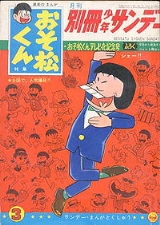
Bessatsu Shonen Sunday
Encyclopedia
was a monthly manga
magazine published by Shogakukan
in Japan
from Spring 1960 until March 1974. It was initially published quarterly, but switched to a monthly release beginning in December 1964. Due to sluggish sales and the paper shortage caused by the 1973 oil crisis
, the magazine's last issue was the March 1974 issue. There was also a spinoff magazine called "Deluxe Shonen Sunday", but it too didn't last long.
Manga
Manga is the Japanese word for "comics" and consists of comics and print cartoons . In the West, the term "manga" has been appropriated to refer specifically to comics created in Japan, or by Japanese authors, in the Japanese language and conforming to the style developed in Japan in the late 19th...
magazine published by Shogakukan
Shogakukan
is a Japanese publisher of dictionaries, literature, manga, non-fiction, DVDs, and other media in Japan.Shogakukan founded Shueisha which founded Hakusensha. These are three separate companies, but are together called the Hitotsubashi Group, one of the largest publishing groups in Japan...
in Japan
Japan
Japan is an island nation in East Asia. Located in the Pacific Ocean, it lies to the east of the Sea of Japan, China, North Korea, South Korea and Russia, stretching from the Sea of Okhotsk in the north to the East China Sea and Taiwan in the south...
from Spring 1960 until March 1974. It was initially published quarterly, but switched to a monthly release beginning in December 1964. Due to sluggish sales and the paper shortage caused by the 1973 oil crisis
1973 oil crisis
The 1973 oil crisis started in October 1973, when the members of Organization of Arab Petroleum Exporting Countries or the OAPEC proclaimed an oil embargo. This was "in response to the U.S. decision to re-supply the Israeli military" during the Yom Kippur war. It lasted until March 1974. With the...
, the magazine's last issue was the March 1974 issue. There was also a spinoff magazine called "Deluxe Shonen Sunday", but it too didn't last long.
Titles serialized
Listed alphabetically by title.- 21emon, by Fujiko F. Fujio
- 4000 Man En Film, Osamu Kishimoto
- Android Kikaider, by Mitsuru Hiruta (1972–1973)
- Hana to Hi to Matsuri, by Shotaro IshinomoriShotaro Ishinomoriwas a Japanese manga artist who became an influential figure in manga, anime, and tokusatsu, creating several immensely popular long-running series such as Cyborg 009 and Himitsu Sentai Goranger, what would go on to become part of the Super Sentai series, and the Kamen Rider Series...
- Jigokubin 3-gōsha, Takeshi Koshiro
- The Return of Ultraman, by Akira Mizuho (1971)
- Kappa no Sanpei, by Shigeru MizukiShigeru Mizukiis a Japanese manga author, most known for his Japanese horror manga GeGeGe no Kitaro . A specialist in stories of yōkai, he is considered a master of the genre...
(1968-1969) - Kikaider 01, by Mitsuru Hiruta (1973)
- Kuranashi Inu, by Kazuyoshi Torii
- Michikusa, by Akio ChibaAkio Chibawas a Japanese manga artist born in Shenyang, Manchukuo . Chiba was known for publishing his works in both shōnen and shōjo magazines. Chiba made his professional debut in 1967 with his manga Sabu to Chibi while working as an assistant to his older brother, Tetsuya...
- Mutant Sub, by Shotaro IshinomoriShotaro Ishinomoriwas a Japanese manga artist who became an influential figure in manga, anime, and tokusatsu, creating several immensely popular long-running series such as Cyborg 009 and Himitsu Sentai Goranger, what would go on to become part of the Super Sentai series, and the Kamen Rider Series...
(1965–1966) - Obake no Q-tarōObake no Q-taro, by Fujiko Fujio, is a Japanese manga about an obake, Qtarō who lives with the Ōhara family. Qtarō, also known as Q-chan or Oba-Q, is a mischief-maker who likes to fly around scaring people and stealing food, though he is deathly afraid of dogs.The story is formulaic, usually focussed on the...
by Fujiko FujioFujiko Fujiowas a nom de plume of a manga writing duo formed by two Japanese manga artists. Their real names are and . They formed their partnership in 1951, and used the Fujiko Fujio name from 1954 until dissolution of the partnership in 1987....
(1964–1965) - Onboro Bakugekitai, Hiroshi SasagawaHiroshi Sasagawais a creator of several anime and manga series. His name is romanized in some sources as Hiroshi Sasakawa.-Career:Well-known as one of creators of "Time Bokan" series , he has directed several animation works in the fantasy and science fiction genre, many of them with Tatsunoko Production.-List of...
- Ore wa Tetsuo-kun, Daisuke Tango
- Ōsenshū Monogatari, Yutaka Yoshida
- Osomatsu-kunOsomatsu-kunis a manga series by Fujio Akatsuka which ran in Shōnen Sunday from 1962 to 1969. It has been adapted into two different anime series of the same name, the first in 1966, produced by Studio Zero, and the second in 1988, produced by Pierrot and aired across Japan on Fuji Television and the anime...
, by Fujio AkatsukaFujio Akatsukawas a pioneer Japanese artist of comical manga known as the Gag Manga King. His name at birth is 赤塚 藤雄, whose Japanese pronunciation is the same as 赤塚 不二夫.... - Silver Kamen, by Mitsuru Hiruta (1972)
- Taishita Hacchan, Katsumi Masuko
- Taizan Daizōno 10-ban Dasha, by Hiroshi Kaizuka
- Thunder Mask, by Kōichi Yamato
- Tsurugi Kengō no Suke, Hisashi Sekiya
- Ultraman Ace, by Mitsuru Hiruta (1972–1973)
- Umi no Ōji, by Fujiko Fujio (1960–1964)
See also
- Weekly Shōnen Sunday

